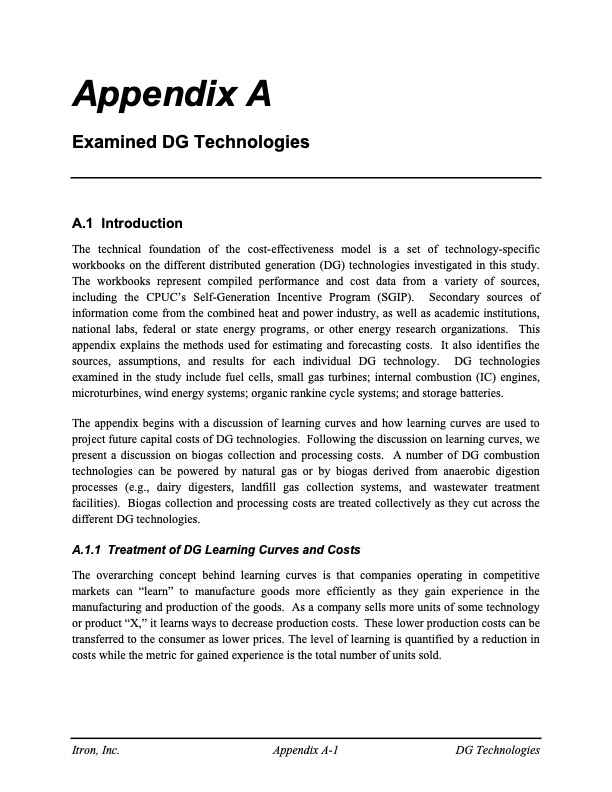
PDF Publication Title:
Text from PDF Page: 142
Appendix A Examined DG Technologies A.1 Introduction The technical foundation of the cost-effectiveness model is a set of technology-specific workbooks on the different distributed generation (DG) technologies investigated in this study. The workbooks represent compiled performance and cost data from a variety of sources, including the CPUC‘s Self-Generation Incentive Program (SGIP). Secondary sources of information come from the combined heat and power industry, as well as academic institutions, national labs, federal or state energy programs, or other energy research organizations. This appendix explains the methods used for estimating and forecasting costs. It also identifies the sources, assumptions, and results for each individual DG technology. DG technologies examined in the study include fuel cells, small gas turbines; internal combustion (IC) engines, microturbines, wind energy systems; organic rankine cycle systems; and storage batteries. The appendix begins with a discussion of learning curves and how learning curves are used to project future capital costs of DG technologies. Following the discussion on learning curves, we present a discussion on biogas collection and processing costs. A number of DG combustion technologies can be powered by natural gas or by biogas derived from anaerobic digestion processes (e.g., dairy digesters, landfill gas collection systems, and wastewater treatment facilities). Biogas collection and processing costs are treated collectively as they cut across the different DG technologies. A.1.1 Treatment of DG Learning Curves and Costs The overarching concept behind learning curves is that companies operating in competitive markets can ―learn‖ to manufacture goods more efficiently as they gain experience in the manufacturing and production of the goods. As a company sells more units of some technology or product ―X,‖ it learns ways to decrease production costs. These lower production costs can be transferred to the consumer as lower prices. The level of learning is quantified by a reduction in costs while the metric for gained experience is the total number of units sold. Itron, Inc. Appendix A-1 DG TechnologiesPDF Image | Cost-Effectiveness of Distributed Generation Technologies

PDF Search Title:
Cost-Effectiveness of Distributed Generation TechnologiesOriginal File Name Searched:
SGIP_CE_Report_Final.pdfDIY PDF Search: Google It | Yahoo | Bing
NFT (Non Fungible Token): Buy our tech, design, development or system NFT and become part of our tech NFT network... More Info
IT XR Project Redstone NFT Available for Sale: NFT for high tech turbine design with one part 3D printed counter-rotating energy turbine. Be part of the future with this NFT. Can be bought and sold but only one design NFT exists. Royalties go to the developer (Infinity) to keep enhancing design and applications... More Info
Infinity Turbine IT XR Project Redstone Design: NFT for sale... NFT for high tech turbine design with one part 3D printed counter-rotating energy turbine. Includes all rights to this turbine design, including license for Fluid Handling Block I and II for the turbine assembly and housing. The NFT includes the blueprints (cad/cam), revenue streams, and all future development of the IT XR Project Redstone... More Info
Infinity Turbine ROT Radial Outflow Turbine 24 Design and Worldwide Rights: NFT for sale... NFT for the ROT 24 energy turbine. Be part of the future with this NFT. This design can be bought and sold but only one design NFT exists. You may manufacture the unit, or get the revenues from its sale from Infinity Turbine. Royalties go to the developer (Infinity) to keep enhancing design and applications... More Info
Infinity Supercritical CO2 10 Liter Extractor Design and Worldwide Rights: The Infinity Supercritical 10L CO2 extractor is for botanical oil extraction, which is rich in terpenes and can produce shelf ready full spectrum oil. With over 5 years of development, this industry leader mature extractor machine has been sold since 2015 and is part of many profitable businesses. The process can also be used for electrowinning, e-waste recycling, and lithium battery recycling, gold mining electronic wastes, precious metals. CO2 can also be used in a reverse fuel cell with nafion to make a gas-to-liquids fuel, such as methanol, ethanol and butanol or ethylene. Supercritical CO2 has also been used for treating nafion to make it more effective catalyst. This NFT is for the purchase of worldwide rights which includes the design. More Info
NFT (Non Fungible Token): Buy our tech, design, development or system NFT and become part of our tech NFT network... More Info
Infinity Turbine Products: Special for this month, any plans are $10,000 for complete Cad/Cam blueprints. License is for one build. Try before you buy a production license. May pay by Bitcoin or other Crypto. Products Page... More Info
| CONTACT TEL: 608-238-6001 Email: greg@infinityturbine.com | RSS | AMP |